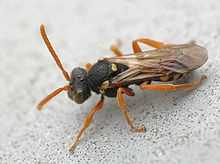Nomadinae
| Nomadinae | |
|---|---|
 | |
| Nomada fulvicornis | |
| Scientific classification | |
| Kingdom: | Animalia |
| Phylum: | Arthropoda |
| Class: | Insecta |
| Order: | Hymenoptera |
| Family: | Apidae |
| Subfamily: | Nomadinae Latreille, 1802 |
| Tribes | |
|
Ammobatini | |
The subfamily Nomadinae (e.g. Nomada, Epeolus, Triepeolus, Holcopasites) is the largest and most diverse group of cleptoparasitic "cuckoo bees" with 31 genera in 10 tribes; they occur worldwide, and use many different types of bees as hosts. As parasites, they lack a pollen-carrying scopa, and are often extraordinarily wasp-like in appearance. All known species share the behavioral trait of females entering host nests when the host is absent, and inserting their eggs into the wall of the host cell; the larval parasite emerges later, after the cell has been closed by the host female, and kills the host larva. The first-instar larvae of nomadines are specially adapted for this, and possess long mandibles they use to kill the host larva, though these mandibles are lost as soon as the larva molts to the second instar, at which point it simply feeds on the pollen/nectar provisions. Another unusual behavioral habit seen in adults of various genera is they frequently "sleep" while grasping onto plant stems or leaves with only their mandibles.
Systematics
- Tribe Hexepeolini
- Hexepeolus
- Tribe Brachynomadini
- Brachynomada
- Kelita
- Paranomada
- Trichonomada
- Triopasites
- Tribe Nomadini
- Tribe Epeolini
- Doeringiella
- Epeolus
- Odyneropsis
- Pseudepeolus
- Rhinepeolus
- Rhogepeolus
- Thalestria
- Triepeolus
- Tribe Ammobatoidini
- Aethammobates
- Ammobatoides
- Holcopasites
- Schmiedeknechtia
- Tribe Biastini
- Biastes
- Neopasites
- Rhopalolemma
- Tribe Townsendiellini
- Townsendiella
- Tribe Neolarrini
- Neolarra
- Tribe Ammobatini
- Ammobates
- Chiasmognathus
- Melanempis
- Oreopasites
- Parammobatodes
- Pasites
- Sphecodopsis
- Spinopasites
- Tribe Caenoprosopidini
- Caenoprosopina
- Caenoprosopis
References
- C. D. Michener (2000) The Bees of the World, Johns Hopkins University Press.